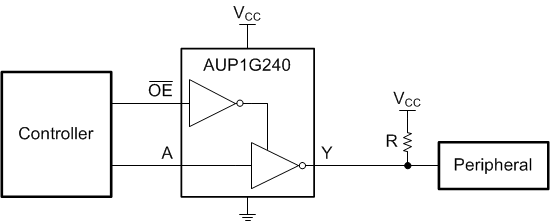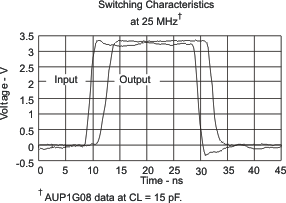SCES627D MARCH 2005 – October 2017 SN74AUP1G240
PRODUCTION DATA.
- 1 Features
- 2 Applications
- 3 Description
- 4 Revision History
- 5 Pin Configuration and Functions
-
6 Specifications
- 6.1 Absolute Maximum Ratings
- 6.2 ESD Ratings
- 6.3 Recommended Operating Conditions
- 6.4 Thermal Information
- 6.5 Electrical Characteristics
- 6.6 Switching Characteristics: CL = 5 pF
- 6.7 Switching Characteristics: CL = 10 pF
- 6.8 Switching Characteristics: CL = 15 pF
- 6.9 Switching Characteristics: CL = 30 pF
- 6.10 Operating Characteristics
- 6.11 Typical Characteristics
- 7 Parameter Measurement Information
- 8 Detailed Description
- 9 Application and Implementation
- 10Power Supply Recommendations
- 11Layout
- 12Device and Documentation Support
- 13Mechanical, Packaging, and Orderable Information
パッケージ・オプション
メカニカル・データ(パッケージ|ピン)
サーマルパッド・メカニカル・データ
発注情報
9 Application and Implementation
NOTE
Information in the following applications sections is not part of the TI component specification, and TI does not warrant its accuracy or completeness. TI’s customers are responsible for determining suitability of components for their purposes. Customers should validate and test their design implementation to confirm system functionality.
9.1 Application Information
The AUP family is TI's premier solution to the industry’s low-power needs in battery-powered portable applications. This family assures a very low static and dynamic power consumption across the entire VCC range of 0.8 V to 3.6 V, resulting in an increased battery life. This product also maintains excellent signal integrity. It has a small amount of hysteresis built in allowing for slower or noisy input signals.
The lowered drive produces slower edges and prevents overshoot and undershoot on the outputs. The AUP family of single gate logic makes excellent translators for the new lower voltage microprocessors that typically are powered from 0.8 V to 1.2 V. They can drop the voltage of peripheral drivers and accessories that are still powered by 3.3 V to the lower voltage levels.
The SN74AUP1G240 is essentially an inverter that can be placed into a high-impedance state. In this application, the output is forced to VCC when the SN74AUP1G240's output is disabled, and when the output is enabled, the device performs the function Y = A.
9.2 Typical Application
 Figure 6. Simplified Application Schematic
Figure 6. Simplified Application Schematic
9.2.1 Design Requirements
SN74AUP1G240 uses CMOS technology and has balanced output drive. Take care to avoid bus contention because it can drive currents that would exceed maximum limits.
Pull-up resistor selection is based on leakage current into the Peripheral's input (II) and the high-impedance output of the SN74AUP1G240 (IOZ). See the next section for equations for pull-up resistor (R) selection.
9.2.2 Detailed Design Procedure
- Recommended Supply Conditions
- A bypass capacitor should be connected between VCC and ground of the device. See Power Supply Recommendations section for more details.
- Recommended Input Conditions
- Rise time and fall time specifications. See (Δt/ΔV) in the Recommended Operating Conditions table
- Specified high and low levels. See (VIH and VIL) in the Recommended Operating Conditions table
- Inputs are overvoltage tolerant allowing them to go as high as VI(max) at any valid VCC, as specified in the Absolute Maximum Ratings table
- Recommended Output Conditions
- Load currents should not exceed the continuous output current maximum rating. See (IO) in the Absolute Maximum Ratings table
- Outputs should not be pulled above the voltage range applied to any output in the high-impedance or power-off state maximum rating. See (VO) in the Absolute Maximum Ratings table
- Pull-up resistor (R) selection depends on three primary factors: desired output high voltage (VOH), which is directly related to total leakage current into the SN74AUP1G240 and the peripheral device's input (IL), desired 0 to 90% rising edge time (tr), which is directly related to the parasitic line capacitance (CP), and the maximum current during low output (IOL), which is directly related to the supply value. These three equations govern pull-up resistor selection:
- R ≤ ( VCC – VOH ) / IL
- R ≤ tr / ( 2.3 × CP)
- R ≥ VCC / IOL(max)
9.2.3 Application Curve
 Figure 7. Excellent Signal Integrity
Figure 7. Excellent Signal Integrity